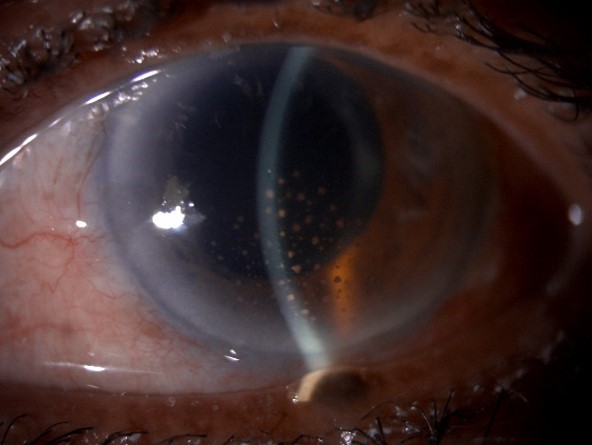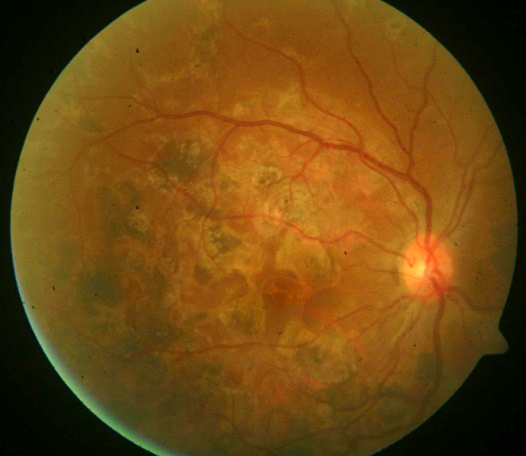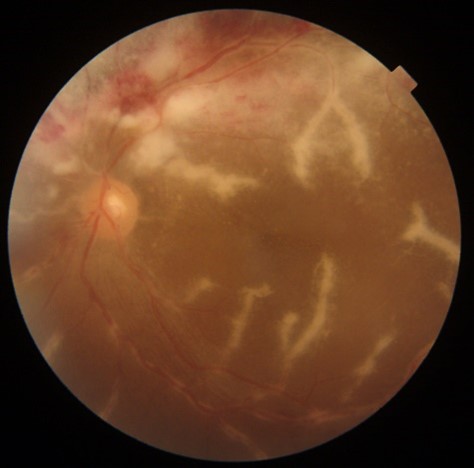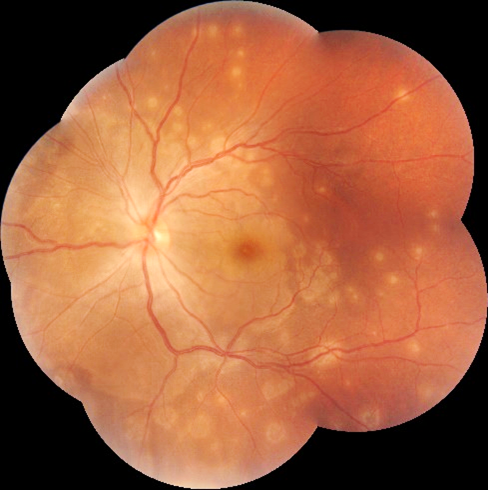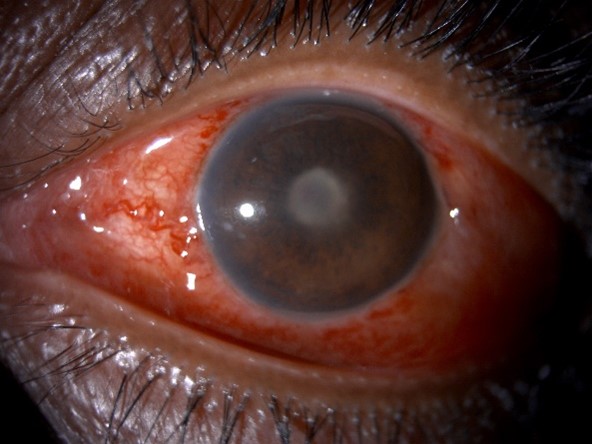The eye is an important sense organ. It is made up of 3 coats. The outer coat is the cornea and sclera. The middle coat is the uveal tract and the inner coat is the retina. The uveal tract consists of 3 parts. The iris is the visible part of the uvea and gives color to the eye (blue, black, brown). The ciliary body is the middle layer of the uvea which manufactures the fluid inside the eye. The choroid is the posterior layer of the uvea which is rich in blood vessels.
Our Uveitis Specialists:
- Dr. Kalpana B Murthy
- Dr. Vidya S Mooss
What is Uveitis?
Inflammation or swelling in any of the part of the uveal tract is called uveitis. Depending on the location of inflammation, it is called anterior uveitis (iris and ciliary body is involved), intermediate uveitis (ciliary body and the vitreous is involved), posterior uveitis (choroids and retina involved), panuveitis (all layers of the uveal tract are involved).
What Causes Uveitis?
Causes of Uveitis are many.
- It may result from an infection (bacteria like tuberculosis, viruses like herpes, parasites like toxoplasmosis)
- It may also be related to an autoimmune disease (with or without involvement of other parts of the body). This essentially is when our immune system recognizes a part of our own body as foreign and elicits a reaction in the form of uveitis. The uveitis may be the presenting manifestation of an underlying systemic disease.
- It can occur as a result of injury to the eye.
- It can occur due to causes within the eye like cataract and retinal detachment
- Sometimes the cause is not known at the first instance. As we follow-up the patient over a period of time, we may be able to pick up new clues or signs suggestive of a systemic disease. In such cases, they are labeled as idiopathic (cause not known) at the initial visit.
What are the Symptoms of Uveitis?
Depending on the structure involved, the symptoms can vary from
- Pain
- Redness
- Inability to see light (photophobia)
- Black spots moving in front of the eye
- Blurring or reduction in vision
How is an Ophthalmic Evaluation Done in a Patient with Uveitis?
An initial examination of the eye will be done, that includes recording of the visual acuity by reading a chart (to check if the vision has decreased), slit lamp examination; (in which a narrow beam of light is shone into the eye so that a magnifying lens can closely examine the highlighted portion of the eye). Intraocular pressure recording (a painless test done by a tonometer); fundus examination (in which the pupil is widened using dilating eye drops so that the ophthalmologist can look into the eye and see structures in the back portion of the eye).
Because uveitis can be caused by many different conditions (infections/autoimmune diseases) diagnosis may require detailed laboratory investigations and a referral to a uveitis specialist.
What Does a Uveitis Specialist Do?
A uveitis specialist is an ophthalmologist who has become proficient in the diagnosis and management of patients with uveitis. He or she has received adequate training in the field of uveitis.
A detailed medical history is elicited. As uveitis can occur due to infection or an underlying autoimmune disease, it is necessary to discover and treat these conditions as well. Routine and specific blood tests related to the immune system/ various infevtions may be ordered to obtain a diagnosis. Scans and angiogram of the eyes may be required if the back portion of eye is involved. This includes Optical coherence tomography (OCT), fundus fluorescein angiography (FFA) and Indocyanine green angiography (ICG). These scans will be useful to know the extent and severity of inflammation. The results obtained in the routine laboratory tests and/or scans will be analyzed by the uveitis specialist and treatment will be advised. Depending on the type of uveitis, a sample of the fluid from the eye may also be sent to obtain a diagnosis by molecular diagnostic techniques. As uveitis may be related to a systemic disease, a cross consultation with rheumatologist, pulmonologist, dermatologist, physician or paediatrician may also be done depending on the diagnosis.
Why is Early Diagnosis of Uveitis Important?
Uveitis is the 3rd leading cause of blindness. Inflammation of the uvea can affect the cornea, retina, sclera, optic nerve and other vital parts of the body. Inflammation inside the eye is a medical emergency because, untreated, it will lead to vision loss. Complications of uveitis are raised eye pressure (glaucoma), cataract development, swelling of retina (macular edema), damage to optic nerve etc. Damage to the eye is preventable if detected early and treated adequately.
How is Uveitis Treated?
The treatment of uveitis aims to achieve the following:
- Relief of pain and discomfort (when present)
- To prevent sight loss due to the disease or its complications
- To treat the underlying systemic disease.
Medical treatment of uveitis must be aggressive to prevent glaucoma (increased eye pressure), to prevent scarring of the structures inside the eye and to prevent possible blindness.
Different medications are used to control the original cause of uveitis, if known and to minimize the inflammation itself. Eye drops especially steroids (to reduce inflammation and pain) and pupil dilators (to widen the pupil and relax the muscles within the eye) are the main medications used to treat uveitis. For deeper inflammations, oral medicines, injections inside or outside the eye or intravenous injections of steroids may be necessary.In cases of suspected tuberculosis related uveits, anti TB medications are required which will be started by pulmonologist. More severe cases of uveitis and those intolerant to steroids may require treatment with immunomodulators like Methotrexate/Mycophenolate mofetil/ Azathioprine or biologics like Adalimumab which will be started and monitored by pulmonologist/rheumatologists/paediatrician. Complications such as glaucoma, cataract or new blood vessel formation (neovascularisation) also may need treatment in the course of the disease. If complications are advanced, conventional surgery or laser surgery may be necessary.
What is the Expected Duration of Treatment?
The duration of treatment varies from person to person and also depends on the type and cause of uveitis. Simple forms of uveitis, for example, may respond to treatment within days and may not recur. Chronic (long term, recurring) forms of uveitis that threaten vision can be very difficult to cure and require persistence on the part of the treating physician(s) and patient. The length of time required to get the disease into a durable remission on steroids or immunosuppressants is difficult to quantify and is very individualistic but the minimum of 2 years is a reasonable estimate. With appropriate, targeted treatment, most people with uveitis will become well controlled and progress to emission. Once in remission from uveitis, you should expect to have regular follow-up visits to our doctor to make sure that the disease remains in remission.
Medications have to be followed properly as per the advise of your doctor and donot stop the medicines even if you are symptom-free without doctors advise. In case of recurrence of uveitis consultation with uveitis specialist is mandatory and one should not self medicate himself/herself.
You have to Help to Save Your Sight.
Find support and encouragement from your family, friends and others. Sometimes it helps to talk to people who have experienced the same thing. It can help you to discuss side effects, share ways to remember your medicines and celebrate getting your uveitis under control. Unfortunately, there are a few people who will lose vision despite commitment to working with their eye doctor and following their treatment plan.
The future holds great promise for uveitis. New medicines and treatments continue to be developed. In the meantime, take heart in knowing that we are doing everything possible to treat your condition. The doctor/patient team approach, support from others and promising scientific discoveries will help you look forward towards a bright future.
Following websites are user friendly and provide further information regarding uveitis patient information groups:





